How To Make A Platformer Fighting Game
Dan Fornace's ten Tips for Making a Fighting Game
And then you've decided you want to make a fighting game. Or y'all're already making a fighting game. Or y'all enjoy playing fighting games. Or you came here from my Twitter which you only follow because you lot like seeing pictures of my domestic dog.
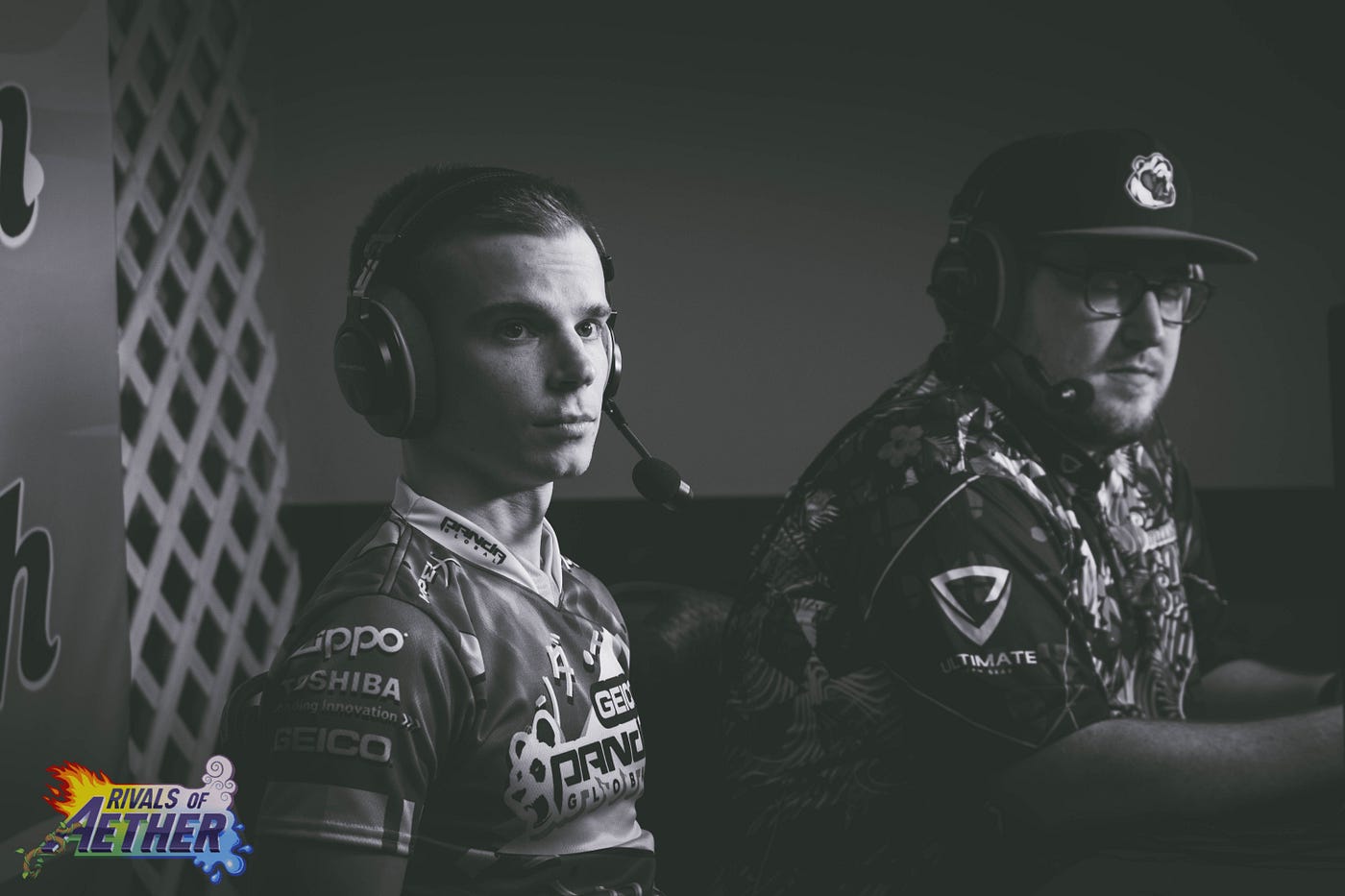
If any of those apply to y'all, and then you've come to the right identify. In this article I'chiliad going to give y'all 10 Tips that will assist you make the best fighting game possible. These tips are mostly directed at designers only spill over into art direction and programming too. These tips are for games of all sizes whether y'all're starting one on your ain or working with a bigger team.

If you're wondering why yous should listen to me. I created the indie fighting game, Rivals of Aether. I've also been working on fighting games for 10 years at present. Wow, I'm old. But if that doesn't impress you then maybe my sick writing skills will.
1. Fun before Balance
This is a concept that I've brought up in the by on Twitter, but it's worth bringing upward over again as the first tip. I believe that a lot of game developers look at a fighting game equally a difficult genre and the thought of balancing all the variables that goes into a fighting game seems like a monumental chore.
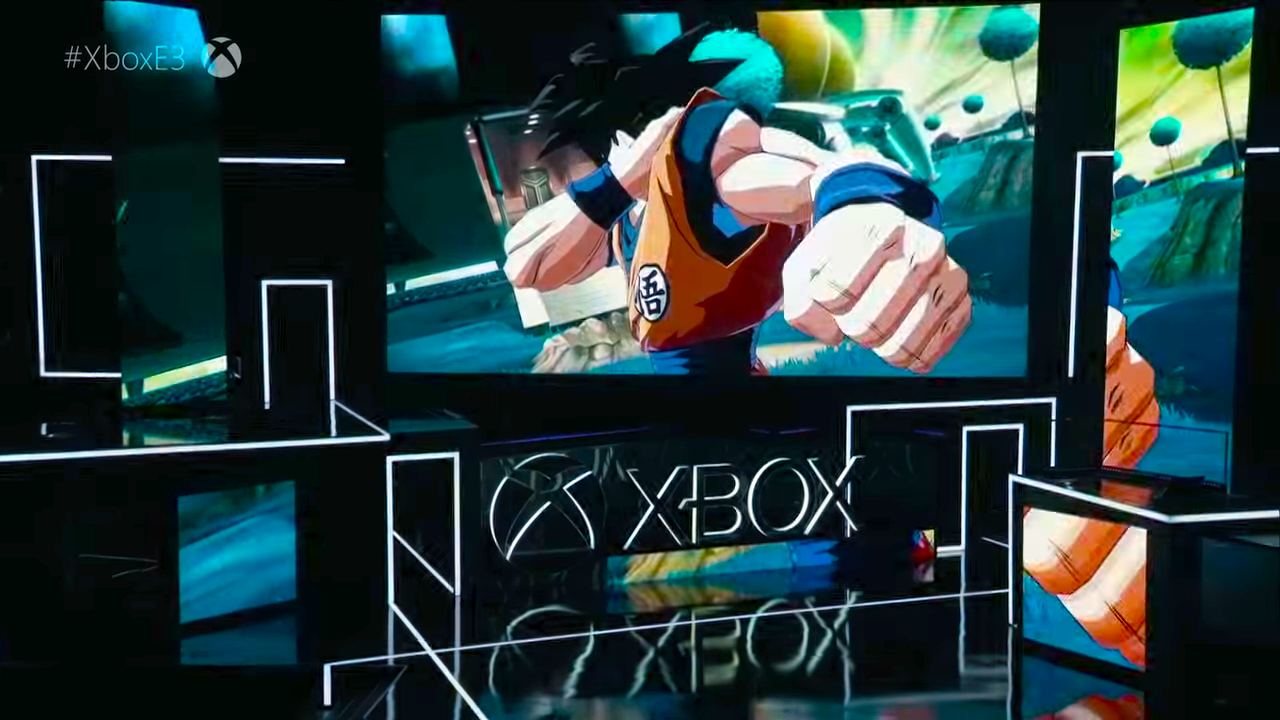
My statement is that these developers are putting the carriage earlier the horse. It won't matter if your fighting game is counterbalanced if no i is playing information technology. When a trailer rolls at E3, no 1 says "Oh that looks like a perfectly balanced fighter! I'll definitely buy that." The driving force for interest and a later buy is whether or not the game looks fun. Presentation obviously plays a big function in this but a fighting game existence fun is both how you get players in the door and go them to share it with their friends.
Focusing on balance too early can negatively touch on the development of your game. Worrying about remainder as you are designing new concepts tin atomic number 82 you to make conservative choices early. And this spirals downwards the development wheel until you end up with watered down designs. Game design as the project continues is almost refining and making systems work together. If the initial idea is tame then it's difficult to make it more elaborate over time. Simply if the initial idea is wild and unbalanced then it's easier to refine it into a balanced piece of your game while retaining what makes it unique.
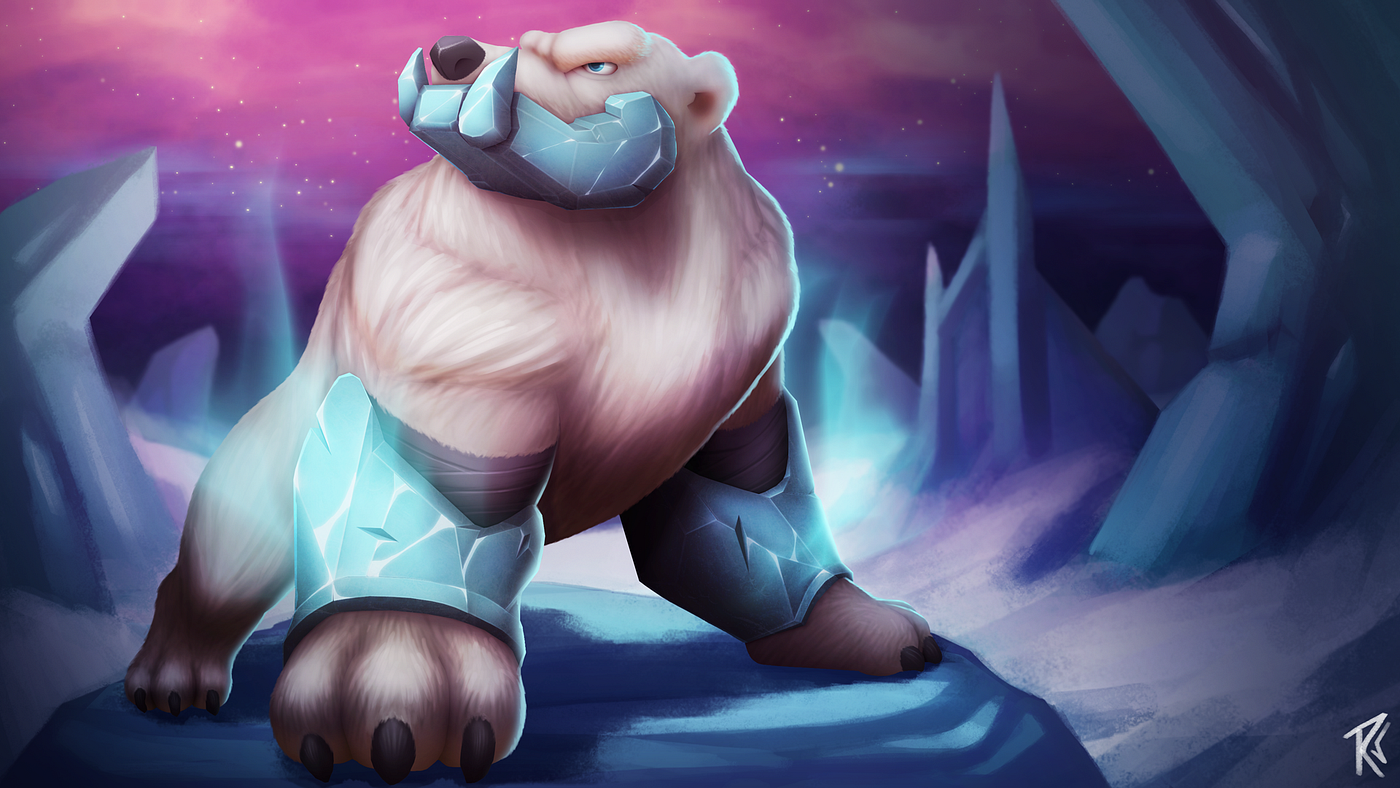
The idea of a perfectly counterbalanced fighting game is a myth and non actually something that you should set out to reach. If that was a design pillar on your projection, you would be tempted to make a homogenized roster where characters have similar tools, movement properties and frame data. Instead prepare out to give your characters their own identities and playstyles. When adjusting their balance, don't be afraid to push them fifty-fifty farther toward a drinking glass cannon or slow tank. It can exist easier to announced like a balanced game when every character is so dissimilar that it'due south hard to tell how they stack upwards against each other. This strategy can also accentuate player preferences and requite you more varied tournament results. Maybe you'll never need to balance your game and people will argue near tier lists until the end of time.
2. Rollback is Required
Rollback netcode is a method of setting up your online play to predict frames in lodge to achieve a lower and stable input filibuster. The alternative is delay based netcode which but increases input delay for worse connections. Rollback is the superior method especially when y'all give users command over their rollback values.
For those who have been post-obit fighting games closely, you lot could say that rollback netcode should take been required for all fighting games starting in 2006 with the release of GGPO.
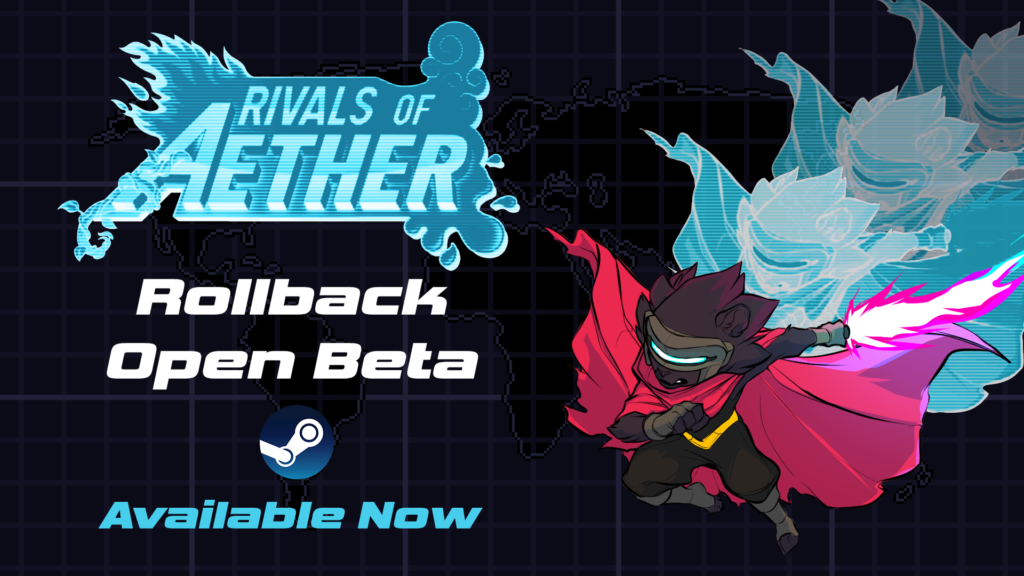
Unfortunately there are nevertheless large fighting games with delay based netcode. Fifty-fifty my own game Rivals of Aether launched without rollback netcode in 2015. It turns out that launching a game without rollback netcode makes adding it back in extremely hard. We started working on rollback in 2017 but just launched an open up beta for testing our rollback solution in September 2021. This is 1 reason why you run across a lot of games without it. They are building on top of engines and previous games that would accept massive overhauls to get rollback to work. Some other reason is that a lot of fighting games come up from Nippon where the distance between players is low and cyberspace connections are great so rollback is less required when playing against opponents in their ain region.
Simply if 2020 has taught the states anything, information technology'southward that the days of filibuster based netcode are over. In 2015, I would accept told you lot that you can't launch a fighting game without online multiplayer. Players and communities take shifted to online and they need to be able to play against each other quickly online. Now in 2021, you tin can't launch a fighting game without rollback netcode.
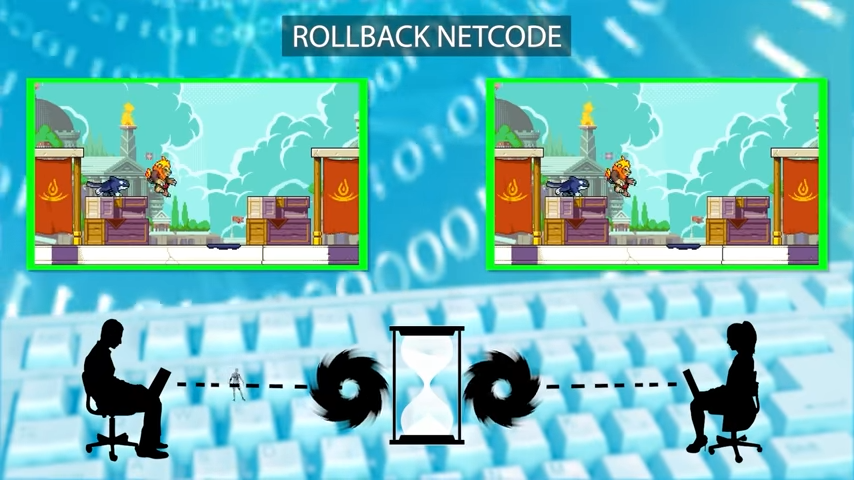
And you need to plan for information technology from the start. From a programmer who has experienced it both ways now, make sure yous research rollback netcode and what is required and get information technology hooked upwards along with your first character. Because while adding in more content that works with rollback is tedious, it's a million times better than trying to get a game with a massive amount of objects and interactions to work with rollback after the game is in players' hands.
iii. Animation is the Foundation
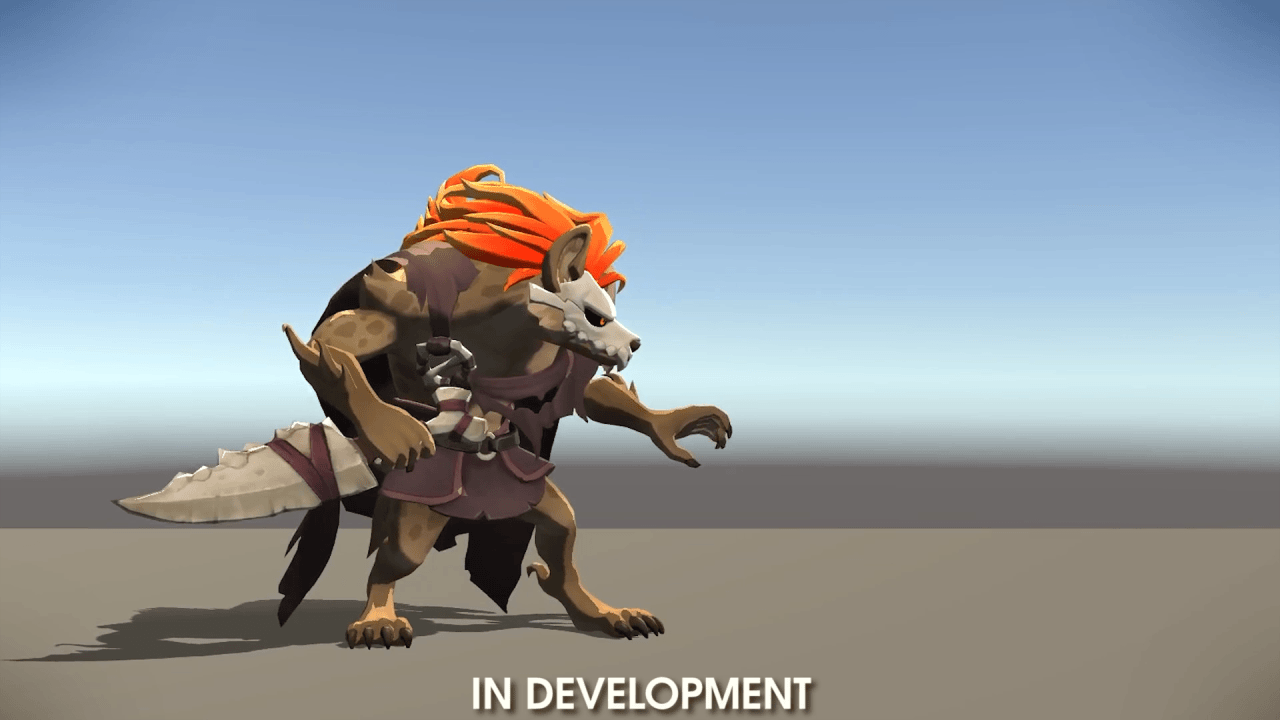
To make a good fighting game, you need skilful blitheness. There really is no way around this requirement. You lot tin can have elementary animation. You lot can have low polygon characters. You can take small sprites. You can take low frame count animation. You can have stepped animation. Simply y'all tin't take bad animation. This is because in fighting games, animation and game feel are intricately tied. The animation is the foundation to your fighting game and the visual effects, sound effects, hitpause, camera effects, and other game feel additions are the dressing.
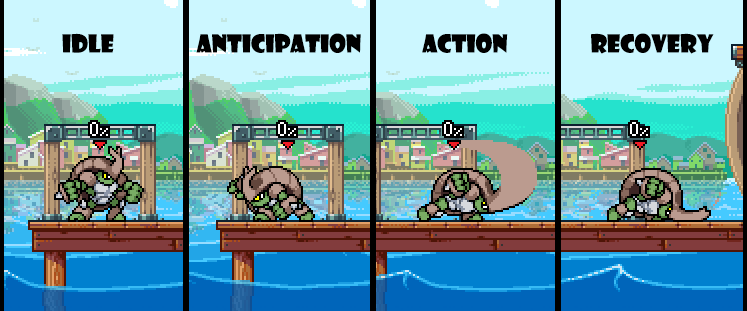
Animation is probably the main expanse where a lot of newcomers to the genre struggle. Why is it that Nail Bros plays so well but when other companies attempt the same formula, it doesn't feel as good? Well, on top of the blueprint and perfecting the dressing, all of the Smash Bros titles are master classes in animation. All the style back to the N64 version, Smash has e'er had bully silhouettes, a good sense of anticipation, stiff keyframes for startup, active and recovery, good employ of squash and stretch, and clearly distinct states.
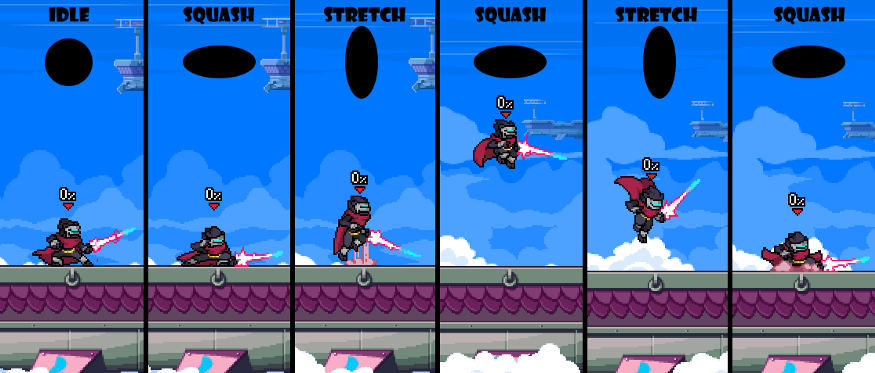
I accept another medium article where I do go into some more detail about animation principles, timing and silhouettes. But the main takeaway is that animating for a fighting game has additional requirements on pinnacle of other game animation. Beingness a great animator in other genres doesn't guarantee your skills will transfer over instantly. This is where having an experienced gainsay designer working closely with your animators can push your game to that next level. Fighting game timing requires a adept bit of adulterous. Characters need to quickly get into their key frames to better your game'southward readability and responsiveness. In one case design and animation get on the same page about the requirements, and so you can beginning cruising through your graphic symbol development.
4. Readability over Beauty
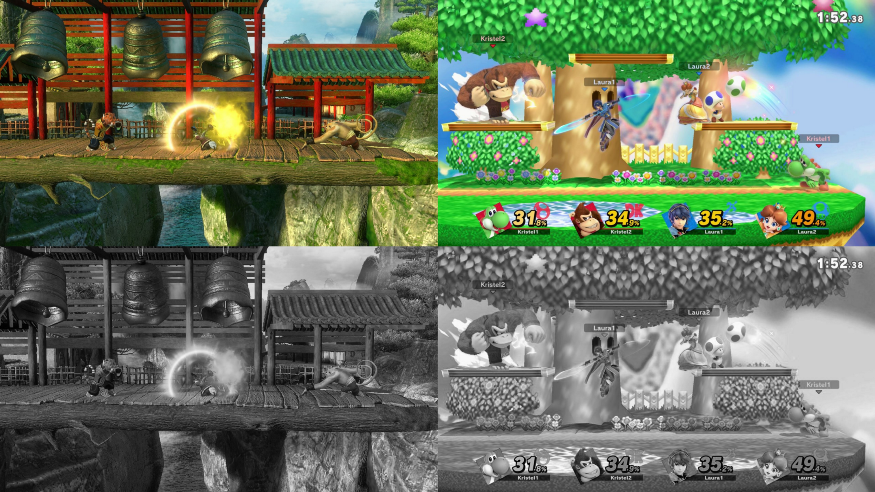
Fighting Games demand to exist readable. Now that you have bully animations because you listened to footstep 3, you lot need to make sure that people tin can come across them. First, your characters need to pop out from your backgrounds. You can achieve this by making sure your characters have more saturation and contrast than your background elements. Here is a contrast hierarchy copied over from my previous commodity:
- Characters: Highest Dissimilarity
- Projectiles and Character Manufactures (ex. Kragg Rock)
- Stage Elements with Standoff (grounds, walls, platforms)
- Shut Groundwork Elements
- Far Background Elements: Lowest Contrast
Next you demand to brand sure that your visual effects are non blocking your animations. Yous want them to accentuate pivotal moments but not obscure the gameplay for you or your opponent. One fox that Rivals of Aether does is nosotros obscure the histrion getting hitting inside hit effects but reveal the attacking histrion. The player getting striking is in hitlag then goes into hitstun and is more predictable than the attacking player who can migrate or sometimes do a cancel while the visual effect is still happening. In platform fighters, you desire to run into the attacker and so the defender tin can clearly see what hit them and DI.
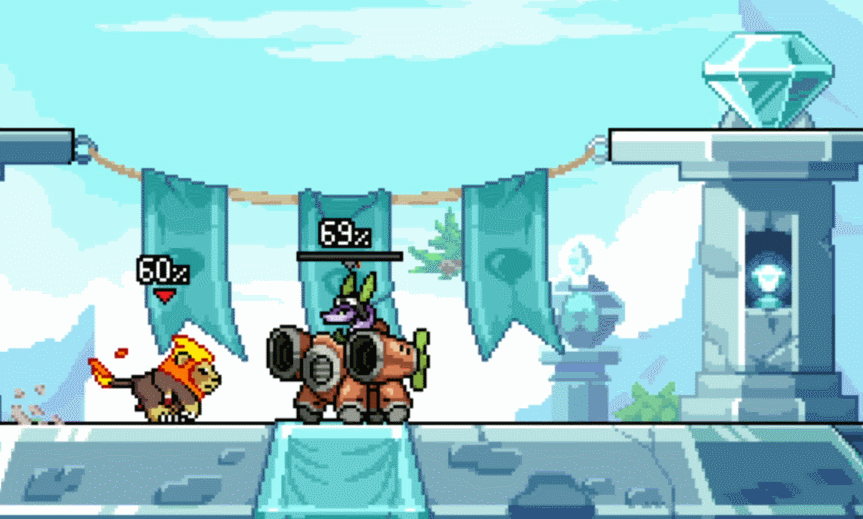
Finally you desire to make certain your photographic camera and your HUD are not hiding information. If you lot have stage hazards or character traps and so make sure people can see them or display indicators. Spend time to brand sure your camera displays the action yous demand without beingness then jerky that information technology's difficult to look at. Both players should have all the information they need to make quick choices. Y'all want to make certain players are fighting each other and not the game. Y'all likewise want to make certain that the game is fun to spotter and follow along even if you lot are not playing it.
v. Responsive not Fast
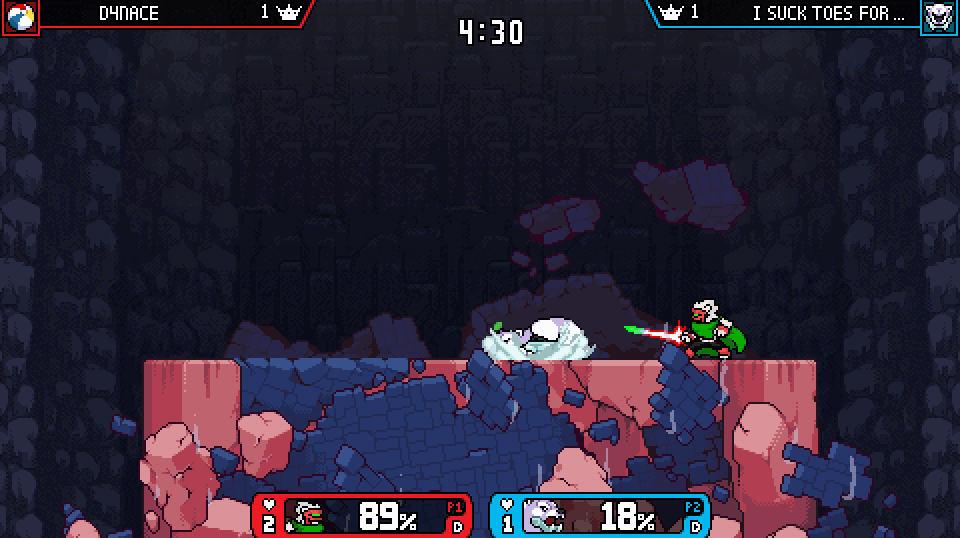
Recently in platform fighters, we take seen a trend toward "faster" and more technical gameplay. Our game, Rivals of Aether, is part of this trend as we tend to have lower recovery, depression landing lag and quicker motility options than some of our contemporaries in the platform fighter genre.
Merely "faster" should not really be your goal. A fighting game doesn't demand to be fast to feel good. If you make everything in your game faster then nothing is fast in comparing and the game eventually becomes hard to control or picket. Y'all need tedious actions and then that the fast deportment actually feel fast. Yous want to take a balance and design attacks with varying startup where some you can react to and others you cannot and then players can both express their prediction skills and use their reflexes. You also want to have attacks that are have quick recoveries and are "condom" and others with long recoveries that are piece of cake to punish. If everything in your game is fast with quick startup and quick recovery, so the gameplay will suffer as combat becomes samey.
But while your game does non demand to be fast, information technology does need to be responsive. Making your game responsive is a 2 front attack. One is from design and the 2d is from programming.
The pattern front was mentioned in the blitheness tip, simply the goal is that all your actions should feel responsive. The frame afterward a button is detected, your character should be getting into their cardinal-pose for that action. Within 1–3 frames depending on the action and the length of the startup. In other games, yous might accept a transition from i state to another where the grapheme slowly blends out of idle. You don't desire that in a fighting game. You want the character to pop into activeness. If yous have a ho-hum blending transition then the button is only going to feel laggy every bit the showtime few frames look as well close to idle and you can't tell that the game has fifty-fifty received your input. Now you lot have to exist aware of only how much you are popping because too much motility in a single frame volition be jarring. Yous'll need to take a handcrafted approach. Nigh fighting games run at 60 FPS and are blithe by hand for every frame. Yous don't run into much interpolation unless it's programmatically washed to cover state transitions. Get into your poses quickly but too be fix to create a lot of animations for all kinds of transitions so your game tin feel both polish and responsive.
Along with animation, the blueprint front continues to all feedback in the game. Sound Effects should play every bit early on as possible and be designed to give yous the tell as soon as they can without much build up. If you want players to be able to react to "FALCONNNNN PUNCH" and dodge when they hear Falcon then make sure it's audible and early into the startup. The aforementioned strategy works for visual furnishings. Hit effects shouldn't scale up slowly to a crescendo like in other games. They need to start big and and then explode fifty-fifty bigger. Equally soon equally the hit happens, y'all desire the game state to be noticeably dissimilar. Yous want both performing and landing attacks to experience tight and responsive. These VFX and SFX rules can be broken to hide rollbacks but it volition affect how your game feels locally if you have delayed reactions.
The programming front end of the assail is the fight against input delay. A fighting game is going to experience worse the higher the input delay is. In that location really is no style effectually that. A lot of great games accept struggled with input delay for a diversity of reasons. Sometimes this challenge is out of your hands especially when using a game engine and especially on certain platforms. You lot should put free energy in getting your delay equally low as possible on your flagship platform even if you can't get it downward on all your platforms.
The second half of the programming forepart is the second tip - you lot demand to have rollback netcode. With rollback, you can keep the input delay to a reasonably depression amount even when playing online. Make sure you are optimizing your game and designing it with rollback in mind from the very start.
six. Create Spectacle Moments

Fighting Games need spectacle moments. This is something that the genre has improved on profoundly over the last 10 years. In fighting games, you want role player actions to take a scale of feedback. You don't want all deportment to have the same amount of feedback. From your lightest attacks to your craziest super, y'all desire to ramp upwardly the visual and audio feedback to match the impact that is happening on screen.
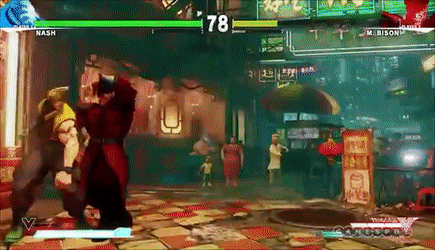
A lot of indie fighting games struggle with this because spectacles are expensive. Big and varied visual effects are harder to create and fit into the game'due south fashion than repetitive small flashes. Cinematic supers are extremely expensive when mechanically they offer the same gameplay as a simpler super effect. But y'all desire to spend some time and push your pivotal moments over the top if yous can afford information technology. The value here is ii fold. The first is that players feel rewarded for achieving the hard or limited activity whether that's landing the final blow or activating their Ten Factor. The second is that spectacle moments are a smashing way to sell your game to new players. Even if they don't understand what is happening exactly, they tin sympathise that it's cool. Glasses help guide new players toward getting better. Because if it's cool, then they volition want to figure out how to practice it themselves.
7. Characters need Personality
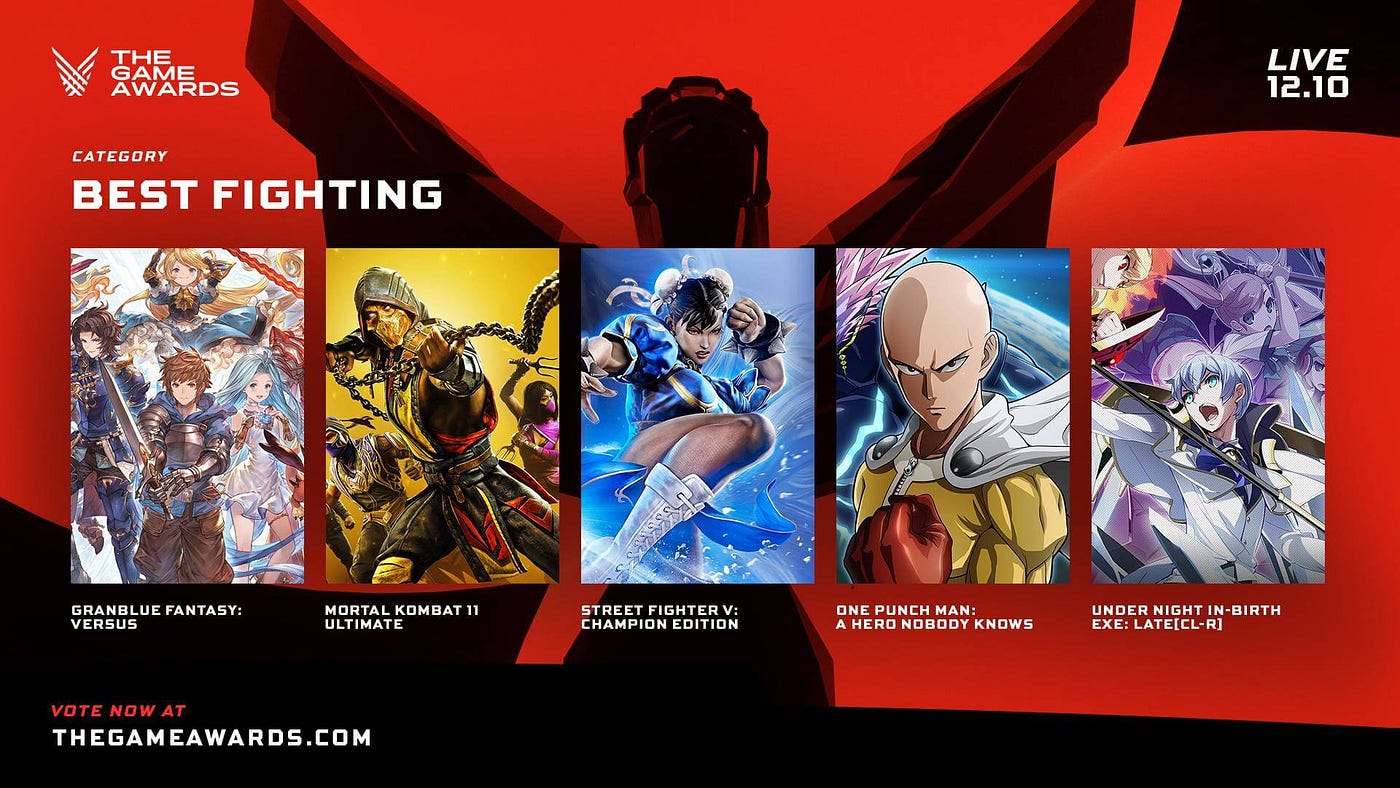
Fighting Games are carried by their characters. But in the mod mean solar day and historic period, most fighting games are not carried by their story modes. You may have noticed that since 2010, pretty much all fighting games fall into three categories: sequels, licensed or indie. Sequels and licensed games are easier bets considering people already care about their characters. They probably already have a favorite character and are excited to encounter how it plays in this iteration. And even if they don't accept a favorite, the roster has a multifariousness of characters pulling from usually decades of content so there is probably some personality that they volition gravitate towards.
Indie games are where we are seeing some fully new rosters come out. But these games oftentimes don't take the budget to create big story adventures or establish their characters exterior the game. For a lot of indies, just making a fighting game with a handful of characters and functional online is a awe-inspiring task.
So what can these indies do to make people care? You demand to requite characters personality during the gameplay itself. Blueprint and animation are not just for moving from point A to betoken B and attaching hitboxes. Yous should be designing attacks, movements and even idle animations to lucifer a personality or gameplay style for your character. If you are making a fighting monk then yous expect that grapheme to be flexible and smoothen. If you are making a steampunk robot, then you would look that character to take more rigid motions. These differences are important and assistance people relate with your characters and choose their favorites without ever reading a single give-and-take of story text.
8. Reduce Menu Time
The nigh fun thing to exercise in a fighting game is to fight people. You want to brand sure that when people are playing a session of your game, they spend as much time every bit possible fighting people. This means that your menus and load times need to exist reduced equally much as technically possible.
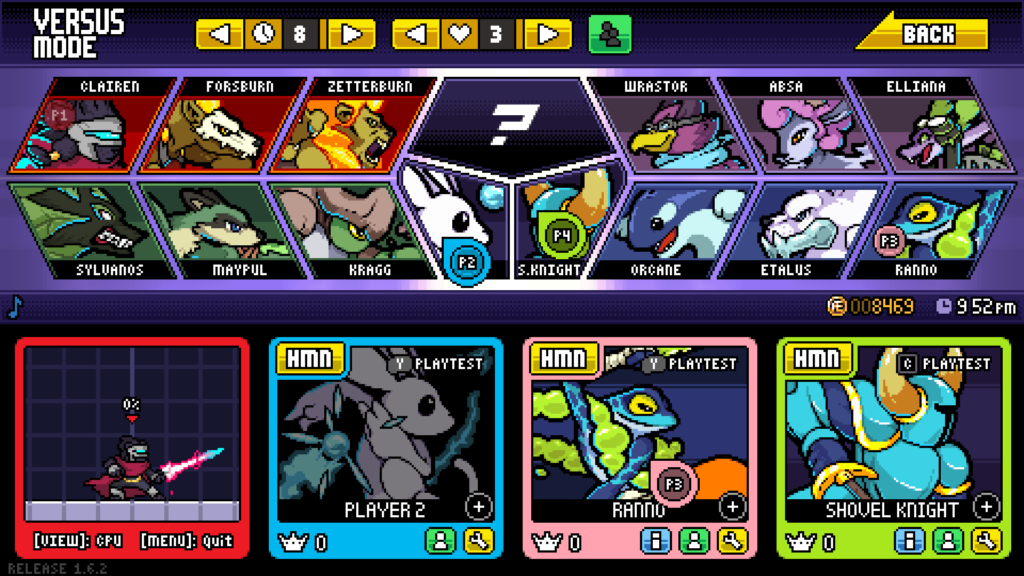
You might be tempted to create flashy menu transitions and cool animations especially when opening grapheme select. And you should do this if you lot can beget it! But go along it as brusque equally possible. Unless you are hiding necessary load times, never make the player wait for a menu to transition. Players are going to be in the same menus hundreds of times so no matter how cool that transition may exist, if it's long, somewhen they volition hate it. This is also true for character intros and outros. Y'all either demand to keep them short or permit players to skip them.
When it comes to online play, you want to follow the same principles. You can add fun modes and interesting vestibule systems, but your quick match option should be quick. Lucifer up two players near the same skill as rapidly as possible and get them playing a friction match within seconds of finding their opponent. This will help your game look amend on streams because you'll be showing off more game time and less menus.
ix. Loftier Level Play should look cool
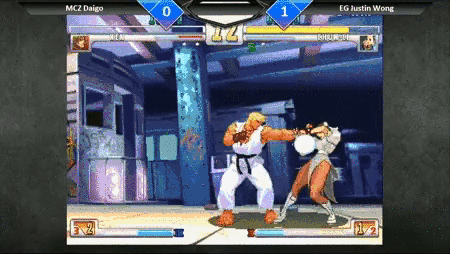
This is a down-the-road problem for most projects, but information technology'southward something to consider since we are developing in an age with such rapid user feedback and interaction. Basically, every videogame volition eventually be played optimally. And if you want your game to exist fun to watch then the tournament level needs to look cool and aspirational. This has 2 caveats.
First the optimal style of play needs to exist impressive to viewers who are fans of your game and competitive games in general. If your top strategies are considered "lame," then expect at your design to see what could be triggering this reaction. Are y'all lacking feedback? Are y'all defective counters? Are you defective technical difficulty? Sometimes the trouble lies in perspective and not the game itself especially with fans coming from other games, but other times you lot'll take a communication issue where the cool and difficult fine details in your game are not coming across to viewers due to lack of feedback.
Secondly, the optimal way of play tin't await too janky. If you make move options or cancels that are the best then make certain that character doesn't await broken when using these cancels to traverse the stage. The joke hither is Melee wavedashing and dash dancing, just honestly both of those states break downward quite well to illustrate what is happening on screen. But you could hands have a situation where optimal motility looks bad and detracts from the experience.
Make sure you are watching and recording competitive play during your game's development and brainstorm ways to make your game more spectator friendly. Most of your fans will meet a video of a game as their kickoff impression so you'll desire to claw them in fifty-fifty if they aren't playing information technology.
ten. Work with your Community
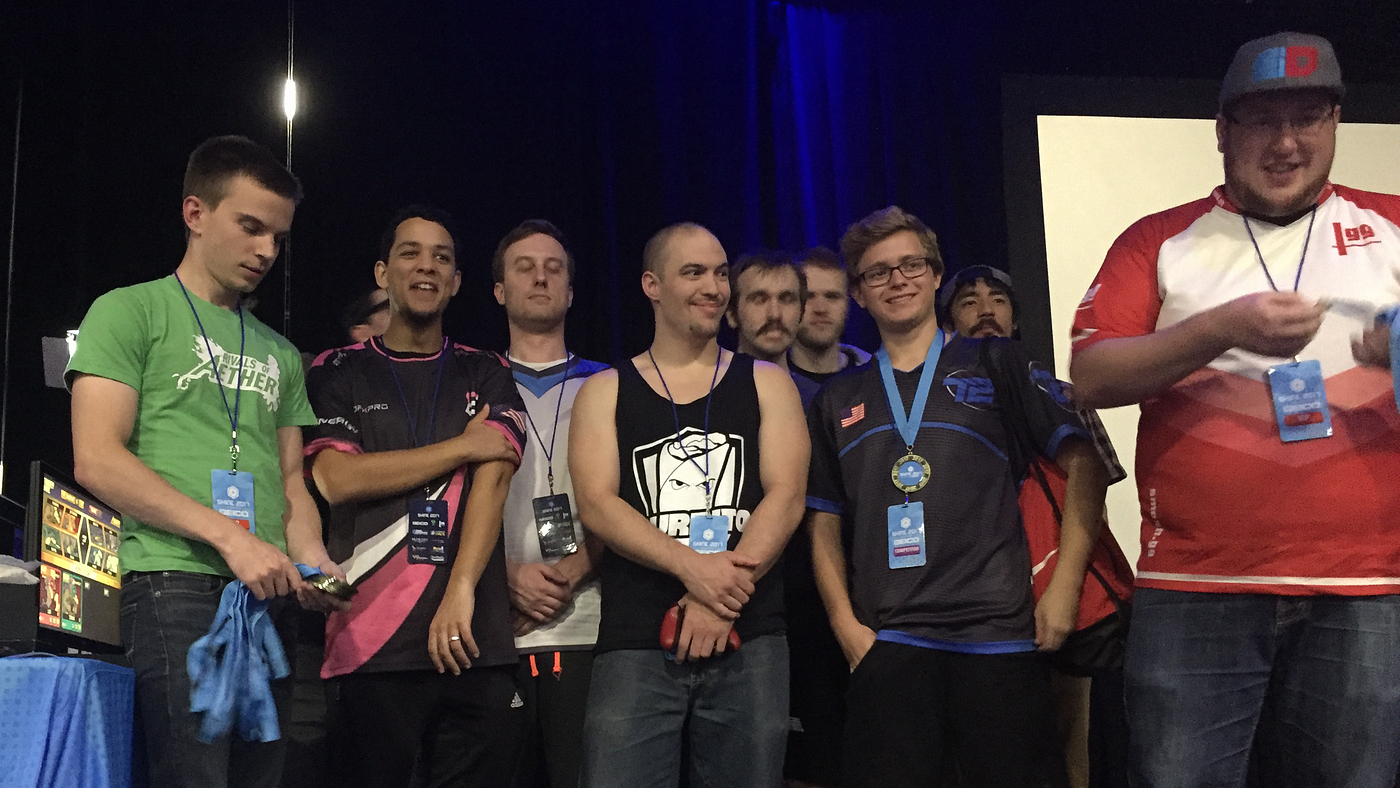
This final tip may seem obvious only there are a couple tips embedded in this 1. The first is that you want to build a fighting game with your community in mind. If y'all are making your game with contest at the forefront then work on having rules and features that match what your competitive fans want. For example, your ranked play should have best out of 3 sets if that's what yous expect your fans to adopt. Once your game comes out, y'all should work with the community to adjust the rules according to how people are actually playing. If tournaments are banning a stage because it's an eye sore, a bad layout, or causing slowdown then update the stage to resolve the problems and then it can fit back into the rotation. You want your own official tournaments and the game itself to suit to how the community is playing and prioritize features that are highly requested in your updates.
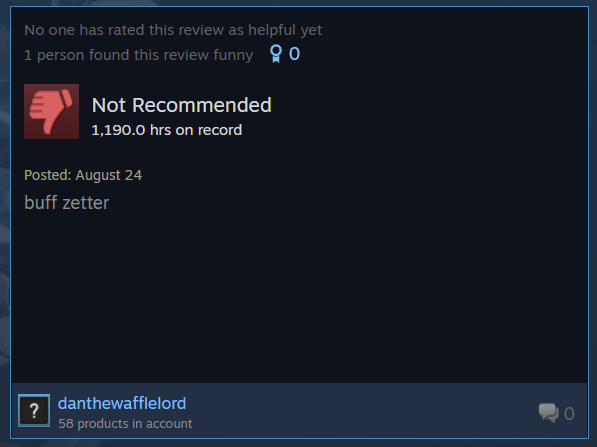
The second tip buried in this last one is that the tip doesn't say "Mind to your Community." Instead it says "Work with your Community." This is because while your community is ofttimes very practiced at detecting problems, they are non e'er the all-time at coming up with the best solution for your game. Information technology'southward up to the designers on your team to really get to the crux of the issue. Sometimes it'south obvious only the fix isn't easy. Other times the bodily problem is buried under negative feedback and player salt and the solution tin can exist a much lighter bear on than the community is clamoring for. At the end of the 24-hour interval, y'all and your team should know what is all-time for your game. You have the vision. You set out with your original goals. Work with the customs but it'south up to you to decide which problems yous accost and how y'all address them.
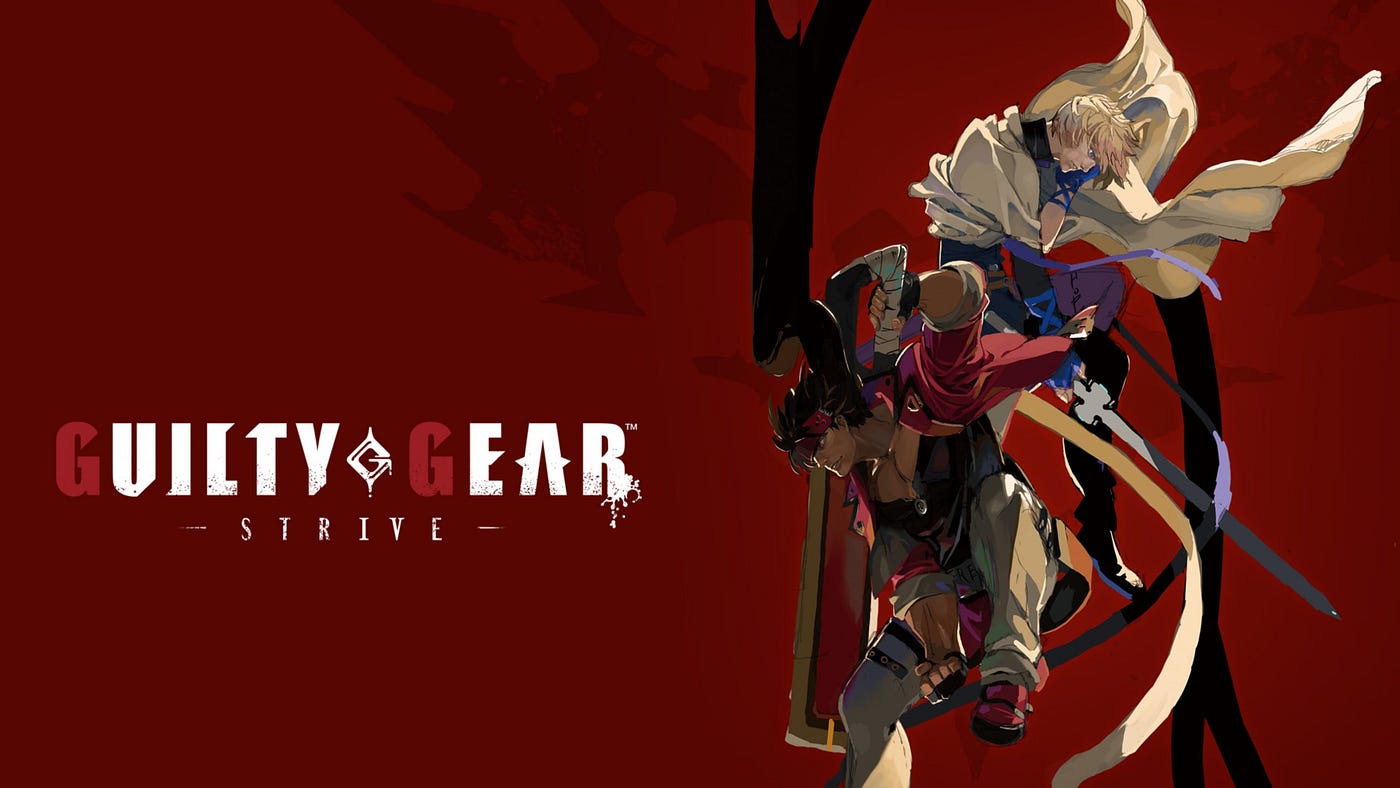
And that's my 10 tips for building fighting games in 2021. This year has been an amazing year for fighting games and it looks like even more great titles are on the horizon. If you have a game you lot are working on that you want me to cheque out then feel free to reach out to me on Twitter. I would love to see what you're cooking up!
How To Make A Platformer Fighting Game,
Source: https://fornace.medium.com/dan-fornaces-10-tips-for-making-a-fighting-game-e2c982da2396
Posted by: hendrickafters.blogspot.com


0 Response to "How To Make A Platformer Fighting Game"
Post a Comment